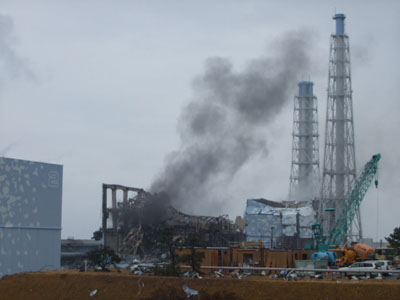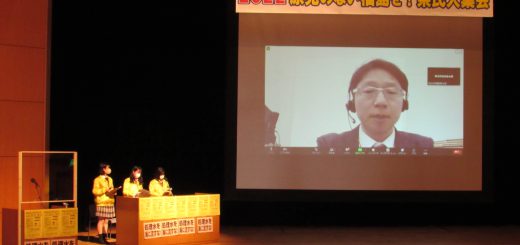Government Investigation Committee Releases Interim Report Nuke Info Tokyo No. 146
Tossed about by an Earthquake, Tsunami and Nuclear Disaster Fukushima Daiichi Nuclear Power Station.
Government Investigation Committee Releases Interim Report
 |
| Photo by TEPCO released March 21, 2011) |
Background
The “Fukushima Daiichi Investigation Committee on the Accident at the Tokyo Electric Power Company Fukushima Nuclear Power Station” released an interim report on December 26, 2011, over nine months after the March 11 Great East Japan Earthquake. The main report spans 507 pages with a further 212 pages of attachments. There is also a 22 page English translation of the Executive Summary. The Committee aims to produce a final report around summer 2012. (Website addresses Japanese_icanps.go.jp/post-1.html, English_icanps.go.jp/eng/interim-report.html)
The Investigation Committee was established by the May 24, 2011 Cabinet Decision for the purpose of ascertaining “the causes of the accident and the causes of the damages inflicted by the accident.” The Committee was asked to “to carry out a multifaceted investigation and verification from the point of view of the people” and “to present policy recommendations for preventing the spread of damages caused by the accident and the reoccurrence of similar accidents.” (Quotes taken from the Prime Minister and Cabinet website on June 7, 2011.)
Professor Yotaro Hatamura, renowned for his study of the mechanisms of “failure,” was chosen to chair the Committee, which has ten members in all. The Chairman appointed two technical advisors and the secretariat included bureaucrats from various ministries, along with eight other people with expertise in areas including society and technology, analysis of severe nuclear accidents, and evacuation. The following three teams were formed under the leadership of experts in the respective fields: Social System Investigation Team, Accident Causes Investigation Team, Damage Expansion Prevention Measures Investigation Team.
Special features of this Committee include its independence from the nuclear bureaucracy and the fact that it was tasked with carrying out a comprehensive investigation that focused not only on technical issues, but also on systemic issues.
The Commission based its investigation on the following eight principles:
- The investigation will be conducted based on the approach of the Chairman, Prof. Hatamura;
- The investigation should produce a result that is capable of standing up to critical evaluation even in 100 years’ time in consideration of the responsibility we have to our descendants;
- The investigation should properly answer all questions asked by Japanese citizens;
- The investigation should properly answer all the questions held by people all over the world;
- The investigation will not seek to hold any particular person or organization responsible;
- The investigation should correctly grasp the precise phenomena of the accident that occurred;
- The investigation should uncover the background to the phenomena that occurred;
- The investigation should, as far as is feasible, conduct replicate experiments and preserve the objects in working condition.
(Extracted from “Remarks by the Chairperson Dr.Yotaro Hatamura at the First Meeting of the Investigation Committee on the Accident at the Fukushima Nuclear Power Station on June 7, 2011”)
As of December 16, the Committee had interviewed 456 people, representing a total of 900 hours of hearings. Based on these hearings, the Committee investigated in considerable detail the course of events that took place in the responses of the Central Government, Fukushima Prefecture and Tokyo Electric Power Company (TEPCO) to the accident, the evacuation of residents and their exposure to radiation. This aspect of the report should be particularly noted.
Content of the Report
In a nutshell, it became clear that a group of people who believed that human beings could control and use this immensely powerful energy turned out to be almost powerless when it came to the crunch. The following specific examples illustrate the point.
- They were unable to grasp what had happened inside the reactor after it was shaken by the earthquake and the lower parts of the buildings were flooded by the tsunami. They did not realize that the Isolation Condenser (IC) in Unit 1 was not operating properly and were unable to quickly inject water into the core.
- Confusion increased as a result of a hydrogen explosion that occurred in the Unit 1 reactor building on March 12.
- Because they were acting on guesswork about the situation and made operational errors, their responses were always too late.
- Due to the jumble of information, they were unable to respond appropriately and neither TEPCO’s nor the government’s command systems operated in a coordinated fashion.
- The initial radiation monitoring required to prevent damage escalation failed.
- SPEEDI (System for Predicting Environmental Emergency Dose Information) was not used. As a consequence great sacrifice was inflicted on residents.
- The Offsite Center did not function. The report shows the resulting state of confusion.
The Fukushima Daiichi accident has not yet been brought under control. The crisis is ongoing, and so the report identified issues and made recommendations on an interim basis. The main points are listed below.
Issues identified
- Measures to protect against tsunamis and severe accidents were insufficient due to the lax judgment of TEPCO, the Nuclear and Industrial Safety Agency and academia.
- This laxity arose from the limitations of voluntary safety measures, the insufficient organizational capabilities of regulatory bodies, and negative effects of specialization and divisions of labor.
- It is a paradox that efforts to improve and search for higher safety are met with negative reactions by others, because such effort may be interpreted as disallowing past practices.
Recommendations
- The operations of the nuclear safety regulatory body should be transparent and it should be made independent of agencies that promote nuclear power.
- Competent human resources with high professional expertise should be secured.
Lessons related to the Unit 1 Isolation Condenser
The first hydrogen explosion occurred at Unit 1. Unit 1 had an item of equipment, called an Isolation Condenser (IC), that was not fitted to the other reactors. When the core pressure rises to dangerous levels the IC is supposed to begin operating automatically, remove high pressure steam from inside the core, condense the steam with heat exchangers, and thus reduce the pressure in the reactor core. The Investigation Committee considered in detail how the operators and TEPCO’s emergency response headquarters dealt with the IC. It concluded that no rupture interfered with the operation of the IC. Rather, it lost functionality as a result of the loss of electric power when the plant was flooded by the tsunami.
However, the Commission said in relation to this item of equipment, “There was no one at the nuclear power plant with many years experience in the operation, including training and inspection, of the IC. Apparently the operators had only exchanged oral accounts amongst themselves about limited operating experiences. Furthermore, although there was some training on the function and operation of the IC, judging from the series of responses on this occasion, we cannot believe this was effective.”
In an emergency, cooling is the highest priority in order to prevent core damage. It can only be concluded that the state of understanding and training in regard to the function and operation of the IC was extremely inappropriate. As the operator of the nuclear power plant TEPCO stands condemned.
An essential condition for maintenance of the integrity of technology is that relevant knowhow be properly passed on to the next generation of operators. People dealing with a technology that is so intrinsically dangerous as nuclear energy must be especially aware of this. At the same time, this should be confirmed at multiple levels by the regulatory body. The lessons from the Unit 1 IC are, therefore, particularly significant.
Impact of the Earthquake
References in the Interim Report to the impact of the massive M9.0 earthquake on the nuclear reactor system are very inadequate. The maximum acceleration in the east-west direction for Units 2, 3 and 5 exceeded the Design Basis Earthquake Ground Motion (Ss*1). The figures recorded in Gals (design basis shown in brackets for comparison) were respectively: 550 (438), 507 (441), 548 (452). I would like to wait for the results of future reports and inspections before commenting in detail on this matter, but based on the experience of the Kashiwazaki-Kariwa Nuclear Power Station after the July 16, 2007 Chuetsu-Oki Earthquake, very careful investigations are called for.
The report mentions a perfunctory analysis carried out by TEPCO for Unit 2. According to this analysis, the load on major equipment and structural components, including the reactor pressure vessel, the containment vessel, and main steam pipes, was within the assessment criteria.*2
However, if the parameters are only slightly altered in this type of calculation totally different figures are derived. Unit 2 was an aging reactor that had been operating for 37 years. I wonder how that fact was considered in the calculation.
Standing up to an evaluation in 100 years time: an ethical issue for engineers and scientists
In its recommendations, the report refers to the need for competent human resources with high professional expertise. However that alone is not enough to prevent the formation of a “nuclear village.” The English version of the Executive Summary uses the word “competent” to translate the Japanese word “yuushuu.” However, “yuushuu” is more commonly translated as “excellent,” or “superior.” Over and above technical or scientific “competence,” it is important that a sense of excellent ethical standards be understood. But how can we expect excellent nuclear safety regulation from Japan’s “nuclear village,” a clique that has demonstrated its lack of ethical standards?
The Interim Report makes the following comment.
“Management of human resources and personnel planning are necessary to enable … staff to formulate [a] consistent career path. Specific steps to this end should include: improved conditions [for] securing competent staff with high professional expertise; enlarged opportunities for … staff to experience long-term training and practical study; personnel exchanges with other administrative authorities or research institutions including those for nuclear and radiation activities.” (Executive Summary, page 20)
But the problem is of a totally different order than this.
If the Investigation Committee wants to produce a report that will stand up to critical evaluation in 100 years’ time, it needs to come up with insightful recommendations and principles addressing this problem. In my opinion, it is necessary to do much more than just educate experts in universities and the like. It is necessary to go back to the elementary and middle school years and reconsider the essence of what education is all about.
I am looking forward to reading the final report, which is due this summer.
(Yukio Yamaguchi, Co-Director)
*1. A ground motion postulated to occur extremely rarely, but which would have a serious impact on facilities if it did occur.
*2. Determined under Japanese seismic design code for nuclear power plants JEAC 4601-2008. The safety requirement for ultimate shear strain is twice that of seismically reinforced concrete walls.

